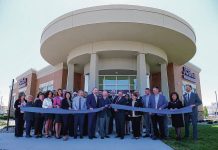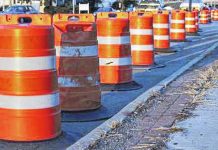The dreaded increase in the number of trains traveling through downtown Columbus, promised for the past three years, is about to begin.
Louisville & Indiana Railroad officials have notified the city that longer, heavier and faster CSX trains will begin traveling through Columbus on L&I’s rail system beginning Nov. 3.
The final hurdle is completion of a new Noblitt Park railroad bridge being readied to slide into place once the old span of the Noblitt Park railroad bridge over the Flatrock River is removed.
That clears the way for the longer, heavier and faster trains coming through the city.
[sc:text-divider text-divider-title=”Story continues below gallery” ]Click here to purchase photos from this gallery
But how much of an inconvenience this will have on local motorists, and how soon, depends upon who you ask.
Motorists may see an immediate increase in the number of trains, their length, their speed and frequency, Columbus Mayor Jim Lienhoop said.
But L&I president John Goldman said it may take up to two months before the impacts become obvious to the public.
“Even then, it won’t be a large increase,” said Goldman, who said CSX officials will review several factors, including how high-speed rails and curves are settling in, before making adjustments.
For example, Lienhoop said train officials will test the tracks to determine the maximum safe speed on a particular stretch of track or curve, and then knock it down about 5 mph as the maximum.
But starting early next year, motorists will likely begin to changes in train volume — currently about eight trains a day — on a monthly basis, Goldman said.
“It could be more trains one month, or it could be fewer,” Goldman said. “A lot will depend on the economy.”
While most of the current CSX trains now carry automotive items, Goldman expects more boxcars carrying general merchandise will be added in upcoming months.
Columbus does have one advantage as compared to other cities along the line, which is that trains slowing down slightly as they move through the downtown, Lienhoop said.
“What we present to the railroad is four curves — coming into Columbus and then going back out,” he said. “The trains will have to slow down for those, but how slow is up to the railroad.”
While travel speeds have not yet been set, Goldman said he anticipates they will be limited to between 30 and 35 mph across the new bridge, as well as at the State Road 46 crossing. Currently, the trains have a maximum speed limit of 49 mph through town, much faster than the 10 mph speed now used to get across the old Flat Rock bridge.
The railroad has been working all year on the final piece of its rail line upgrade, completing a major revamp of that bridge. The century-old crossing needed to be widened for today’s rail traffic and re-engineered to carry double-stacked rail cars the railroad plans to use, Goldman said.
Project approval
Louisville & Indiana Railroad and CSX Transportation won approval in April 2015 from the federal Surface Transportation Board to use L&I’s 106-mile mainline between Louisville and Indianapolis jointly and upgrade it from jointed steel rails to continuous welded ones.
The new rails would allow heavier and faster trains to move through Columbus and other cities along the rail line. The plan calls for CSX, which would invest $70 million to $90 million in improvements, to shift an estimated 13 to 15 trains per day to the L&I line, in addition to the L&I trains.
Examining the railroads’ plan, the federal agency’s Office of Environmental Analysis said the project would not significantly affect communities along the rail line.
However, mayors in cities along the railroad strongly disagreed, and Columbus officials began looking for an alternative fix.
A 2016 study by Indianapolis engineering firm American Structurepoint Inc., commissioned by the city, indicates as many as 22 trains may travel through the State Road 46/State Road 11 intersection, and other Columbus downtown intersections.
If there is a near constant presence of trains on the downtown tracks, it will mean inconvenience for people who want to access Mill Race Park, Mill Race Center or the city bus depot, all on the west side of the tracks from Lindsey Street, Lienhoop said.
But Goldman says the two-year-old study made assumptions that aren’t substantiated today.
Overpass relief
It was predicted in 2016 that the northbound longer, faster and heavier CSX trains could increase the current wait time at the State Road 46 crossing to about 20 minutes after the new bridge opens — and grow to 40-minute delays by 2036.
But project consultants added to their predictions that such impacts would only happen if nothing was done to change the rail crossing configuration.
Last year, Columbus approved the creation of a non-reverting fund to pay for an overpass over the railroad tracks at State Road 46 and State Road 11. That bookkeeping step will allow the city to keep track of costs associated with the project.
The estimated $28 million to $30 million overpass project is between the city and the Indiana Department of Transportation, agreed to pick up half of the total cost. But the city has other partners.
Bartholomew County will pay $1.5 million to the city by Nov. 15, and another $500,000 that will be paid over a two-year period. The city’s share will include $4 million from Central TIF District funds, while other funding sources include about $5.5 million from the Cummins Engine Plant TIF District funds, up to $2.5 million in state or federal highway programs along with cost savings and $1.5 million from CSX and Louisville & Indiana Railroads.
But it will be at least two years before the overpass opens — possibly the fourth quarter of 2020, Lienhoop said.
Local bypass
Until then, motorists and commuters will have to hope that their travels won’t be delayed by a train. West-side residents may consider using County Road 325W and Lowell Road, a popular bypass that goes into southbound U.S. 31 and into the city’s business district on National Road.
While 325W was widened and improved behind the Westhill Shopping Center in 2015, it wasn’t until last year that county highway crews spent $200,000 to significantly soften two sharp curves on Lowell Road. That allowed the speed limit to be raised from 20 to 40 mph in that area in anticipation of both Lowell and 325W being used to avoid long waits for trains.
Although it may not appear that much progress has been made on the overpass, Lienhoop said things are moving along on schedule. Recent architectural digs to determine if any artifacts might be in the soil around the proposed overpass turned up nothing, and offers are being negotiated with property owners for overpass right of way.
“We’re still on the fast track with this project, no pun intended,” Lienhoop said.
Lienhoop said he is concerned about how local drivers will respond when faced with the train delays, and was particularly saddened that two people lost their lives and a third was seriously injured in an SUV-train collision Oct. 8 in Edinburgh.
“Most people don’t understand how quickly a train is approaching,” he said. “They think it is 5 mph to 10 mph, but actually it’s moving 50 mph,” he said. “It will be on you more quickly than you realize.”
[sc:pullout-title pullout-title=”Key dates coming up” ][sc:pullout-text-begin]
Nov. 3: Upgrade of Noblitt Park railroad bridge will be completed, allowing longer, heavier and faster CSX trains to travel through Columbus on Louisville & Indiana Railroad’s rail system.
Nov. 5: An 11 a.m. ribbon-cutting ceremony is tentatively planned for the $12 million bridge upgrade.
November/December 2018: Railroad officials will review factors such as how high-speed rails and curves are settling in before making significant adjustments in the train volume.
Fourth quarter 2020: A $28 million to $30 million overpass over the railroad tracks at State Road 46 and State Road 11 leading into downtown Columbus is expected to open, relieving delays at city rail crossings caused by a higher volume of train trafffic.
[sc:pullout-text-end]




